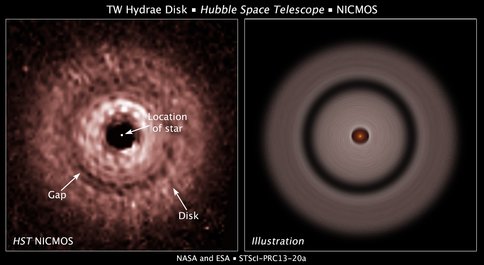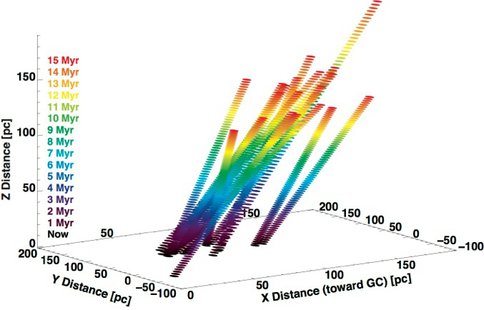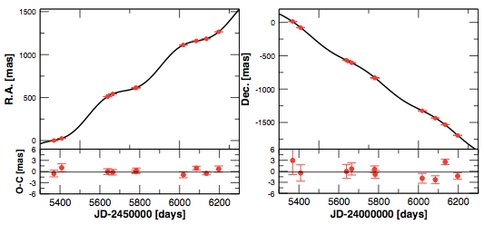2013 Annual Science Report
 Carnegie Institution of Washington
Reporting | SEP 2012 – AUG 2013
Carnegie Institution of Washington
Reporting | SEP 2012 – AUG 2013
Project 1: Looking Outward: Studies of the Physical and Chemical Evolution of Planetary Systems
Project Summary
We continue to apply theory and observations to investigate the nature and distribution of extrasolar planets both through radial velocity and astrometric methods, the composition of circumstellar disks, early mixing and transport in young disks, and late mixing and planetary migration in the Solar System, and Solar System bodies.
Project Progress
1.1 Finding Habitable Planets Around the Nearest Stars
The Planet Finding Spectrometer (PFS) was designed and built by Jeff Crane and Steve Shectman at the Carnegie Observatories, with the goal of achieving world class precision, 1 m s−1, sufficient to detect terrestrial mass and potentially habitable planets around the closest stars. We are garnering ∼50 nights per year on the 6.5-m Magellan II (Clay) telescope at Las Campanas. CoI Butler and post doctoral fellow Arriagada are surveying the nearest 500 GKM dwarfs, including 100 M dwarfs. Our goal is to construct the roadmap to the nearest potentially habitable exoplanets to guide and motivate next generation direct imaging and spectroscopy with advanced AO systems on giant telescopes (GMT, TMT, ELT) and dedicated space-based missions (the successor to TPF and DARWIN). Due to their lower mass and luminosity, potentially habitable terrestrial mass planets can be detected around late K and M dwarfs. The Magellan PFS program has already contributed to the discovery of a handful of low-mass exoplanets, including a Super-Earth in the Habitable Zone (Anglada-Escudé et al. 2012, Arriagada et al. 2013). Figure 1 shows several emerging M dwarfs from the Magellan PFS program.
In addition to the exploration of planets around nearby stars, the Magellan PFS program is collaborating with the HAT-South program to follow up on interesting transit planet detections. Combining Doppler velocities with photometric transit observations allows for the precise determination of planet mass, radius, and density. Figure 2 shows two recent examples: on the left, a saturn-mass planet in a 4.8 d orbit around a faint (V=12.6) G dwarf (Zhou et al. ApJ 2013 submitted). The solid circles are from PFS, the triangles are from the 8.2-m Subaru telescope. The velocity RMS to the Keplerian fit for the PFS data is 3.8 m s−1. The RMS to the larger Subaru telescope is 4.8 m s−1. On the right, the PFS Doppler velocities for the first known transiting hot jupiter around an M dwarf are shown. At V=15.1, this star demonstrates the ability of PFS to achieve high precision, ∼ 5 m s−1, around extremely faint stars. This is a unique capability, and opens up the possibility of surveying a few dozen stars later than M5, a regime as yet unexplored.
1.2 Astrometric Search for Planetary Systems Hospitable for Life
Co-I Boss leads the Carnegie Astrometric Planet Search (CAPS) project at LCO, while
Co-I Weinberger and former NAI Fellow Anglada-Escude are key members of the CAPS team. The CAPS team is undertaking an astrometric search for gas giant planets and brown dwarfs orbiting nearby low mass dwarf stars with the LCO du Pont telescope. We are following 100 nearby (primarily within about 15 pc) low mass stars, principally late M, L, and T dwarfs, for 10 years or more, in order to detect very low mass companions with orbital periods long enough to permit the existence of habitable, Earth-like planets on shorter-period orbits. These stars are generally too faint and red to be included in ground-based Doppler planet surveys, which are often optimized for FGK dwarfs. The smaller masses of late M dwarfs also yield correspondingly larger astrometric signals for a given mass planet. The CAPS search will also help to determine whether gas giant planets form primarily by core accretion or by disk instability around late M dwarf stars, and help with the census of nearby stars.
Our latest paper (Anglada-Escude et al. 2013) involves observations of GJ 1214, which is known from radial velocity observations to be orbited by a super-Earth-mass planet that also transits the star. GJ1214b is a prime target for ongoing efforts to understand the population of super-Earth-mass planets orbiting M dwarf stars, including some that orbit with the habitable zone. We have obtained a distance to the star GJ1214 accurate to 1.5 % using CAPSCam astrometry. This new value increases the nominal distance to the star by about 10 % and this new distance has a significant effect upon the star’s inferred properties, and hence the extent of the star’s habitable zone.
CAPSCam has been operational for 6.5 years, during which over 900 epochs of observations have been taken on the 100 targets on the currently active list. Another 200 epochs have been taken on targets that have since been dropped from the planet search list, but for which kinematic parallaxes have been determined and will soon be published. The CAPSCam search is just now entering the most exciting phase of this decade-old effort, with a number of targets showing evidence of wobbles that might be caused by unknown companions.
1.3 From Disks to Planets
Co-I Boss is partially supported by the NASA Origins of Solar Systems Program to work on mixing and transport in marginally gravitationally unstable (MGU) disks. This work is being continued and has been extended to include an analysis of the time history of a population of individual dust grains, as they traverse high and low temperature regions of the disk. This will allow a determination of the extent to which water is transported as a solid by the dust grains, through a collaborative effort with Prof. Morris Podolak of Tel Aviv University, who has developed a model for silicate dust grains with water ice mantles. By following the extent to which water ice condenses or sublimates on a population of grains being transported around the disk, a better understanding of the distribution of water in the solar nebula will be achieved, with important implications for the delivery of water to the terrestrial planets.
This project is in full production mode, with a suite of 3D disk models running on DTM’s flash cluster. Podolak visited DTM in July 2013 and worked with Boss and Alexander on an improved treatment of the evaporation and condensation of ices, as well as several silicate minerals appropriate for forming WL rims on CAIs. This modeling effort employs Podolak’s numerical codes for treating the thermal evolution of dust particles as they traverse a fully 3D MGU disk evolving by gravitational torques. Podolak’s Tel Aviv U. student Idan Lavy has begun work on these problems as well, and is currently working on a new code that tracks the chemical interactions of both small and large grains as they traverse the trajectories calculated by Boss’s 3D gravitational hydro code, which contains the physics necessary for treating small particles in the solar nebula, namely the Stokes and Epstein gas drag laws.
New models are underway that deal with the evolution of small particles initially distributed throughout the solar nebula. MGU disk phases are thought to result in the FU Orionis outbursts that are common in young solar-type stars.
1.4 Compositions of circumstellar disks and delivery of volatiles to terrestrial planets
Co-I Weinberger and former CIW postdocs John Debes, Hannah Jang-Condell, and Aki Roberge completed a new study of the spatially resolved spectrum of the disk around TW Hya. They discovered evidence that an extrasolar planet may be forming quite far from its star—80 AU, about twice the distance Pluto is from our Sun. They observe a partial gap in the disk that could be opened by at 15- 30 Earth mass planet. It is surprising to find a planet only 5 to 10% of Jupiter’s mass forming so far out since planets should form faster closer in. In all planet formation scenarios, it’s difficult to make a low-mass planet far away from a low mass star. The goal of these observations was to understand not only whether planets have formed, but also what conditions can result in planet formation and what chemical constituents are available for new planets. Weinberger designed the observations to be able to detect large water ice grains in the surface layer of the disk. These grains weren’t seen, which probably means that they have grown and sunk to the midplane of the disk where they can aggregate into water-rich planets.
Weinberger, along with former postdoctoral fellow Guillem Anglada-Escude and Co-I Boss studied disk evolution in the TW Hya Association by finding the distances to 14 primary members and 2 stellar companions. The median parallax is 18 mas or 56 pc. Pre-main-sequence evolutionary tracks imply a range of ages for the stars with a median of 10.1 Myr and no correlation between age and Galactic location. The TWA stars may have formed from an extended and filamentary molecular cloud but are not necessarily precisely coeval. This complicates using the association as a laboratory for studying disk evolution at the end of the protoplanetary stage.
Postdoctoral fellow Chris Stark, along with Co-Is Boss and Weinberger, searched the Kepler data set for signs of transiting resonant dust structures associated with identified exoplanets. The discovery of resonant populations of planetesimals or dust would provide information on the current and past architecture of the planetary system, inform future exoplanet imaging probes on a critical component of noise, and after subsequent modeling would provide information on the composition of dust in the system. Stark found no evidence for structures associated with hot Jupiters orbiting beyond the dust sublimation radius and limited the frequency of dust structures with optical depths of 100 “zodis” to <18%.
1.5 Searching the Keppler Data Base for Short Period Objects.
Post Doct Jackson and CoI Chambers conducted a search for very short-period transiting objects in the publicly available Kepler data set, revealing four planetary candidates with orbital periods less than 12 hr. Even with masses of only a few Earth masses, the candidates’ short periods mean that they may induce stellar radial velocity signals (a few m s–1) detectable by currently operating facilities, providing unique observational leverage on the natures of rocky exoplanets. Such planets would also be especially amenable to discovery by the planned TESS mission and a re-purposed Kepler mission.
Publications
-
Anglada-Escudé, G., Arriagada, P., Vogt, S. S., Rivera, E. J., Butler, R. P., Crane, J. D., … Jenkins, J. S. (2012). A PLANETARY SYSTEM AROUND THE NEARBY M DWARF GJ 667C WITH AT LEAST ONE SUPER-EARTH IN ITS HABITABLE ZONE. The Astrophysical Journal, 751(1), L16. doi:10.1088/2041-8205/751/1/l16
-
Anglada-Escudé, G., Rojas-Ayala, B., Boss, A. P., Weinberger, A. J., & Lloyd, J. P. (2013). GJ 1214 reviewed. A&A, 551, A48. doi:10.1051/0004-6361/201219250
-
Arriagada, P., Anglada-Escudé, G., Butler, R. P., Crane, J. D., Shectman, S. A., Thompson, I., … Minniti, D. (2013). TWO PLANETARY COMPANIONS AROUND THE K7 DWARF GJ 221: A HOT SUPER-EARTH AND A CANDIDATE IN THE SUB-SATURN DESERT RANGE. The Astrophysical Journal, 771(1), 42. doi:10.1088/0004-637x/771/1/42
-
Batalha, N. M., Rowe, J. F., Bryson, S. T., Barclay, T., Burke, C. J., Caldwell, D. A., … Welsh, W. F. (2013). PLANETARY CANDIDATES OBSERVED BY KEPLER . III. ANALYSIS OF THE FIRST 16 MONTHS OF DATA. The Astrophysical Journal Supplement Series, 204(2), 24. doi:10.1088/0067-0049/204/2/24
-
Borucki, W. J., Agol, E., Fressin, F., Kaltenegger, L., Rowe, J., Isaacson, H., … Winn, J. N. (2013). Kepler-62: A Five-Planet System with Planets of 1.4 and 1.6 Earth Radii in the Habitable Zone. Science, 340(6132), 587–590. doi:10.1126/science.1234702
-
Boss, A. P. (2013). MIXING AND TRANSPORT OF SHORT-LIVED AND STABLE ISOTOPES AND REFRACTORY GRAINS IN PROTOPLANETARY DISKS. The Astrophysical Journal, 773(1), 5. doi:10.1088/0004-637x/773/1/5
-
Boss, A. P. (2013). ORBITAL MIGRATION OF PROTOPLANETS IN A MARGINALLY GRAVITATIONALLY UNSTABLE DISK. The Astrophysical Journal, 764(2), 194. doi:10.1088/0004-637x/764/2/194
-
Boss, A. P., & Keiser, S. A. (2013). COLLAPSE AND FRAGMENTATION OF MAGNETIC MOLECULAR CLOUD CORES WITH THE ENZO AMR MHD CODE. I. UNIFORM DENSITY SPHERES. The Astrophysical Journal, 764(2), 136. doi:10.1088/0004-637x/764/2/136
-
Boss, A. P., & Keiser, S. A. (2013). TRIGGERING COLLAPSE OF THE PRESOLAR DENSE CLOUD CORE AND INJECTING SHORT-LIVED RADIOISOTOPES WITH A SHOCK WAVE. II. VARIED SHOCK WAVE AND CLOUD CORE PARAMETERS. The Astrophysical Journal, 770(1), 51. doi:10.1088/0004-637x/770/1/51
-
Béky, B., Bakos, G. Á., Hartman, J., Torres, G., Latham, D. W., Jordán, A., … Sári, P. (2011). HAT-P-27b: A HOT JUPITER TRANSITING A G STAR ON A 3 DAY ORBIT. The Astrophysical Journal, 734(2), 109. doi:10.1088/0004-637x/734/2/109
-
Debes, J. H., Jang-Condell, H., Weinberger, A. J., Roberge, A., & Schneider, G. (2013). THE 0.5-2.22 μm SCATTERED LIGHT SPECTRUM OF THE DISK AROUND TW Hya: DETECTION OF A PARTIALLY FILLED DISK GAP AT 80 AU. The Astrophysical Journal, 771(1), 45. doi:10.1088/0004-637x/771/1/45
-
Jackson, B., Stark, C. C., Adams, E. R., Chambers, J., & Deming, D. (2013). A SURVEY FOR VERY SHORT-PERIOD PLANETS IN THE KEPLER DATA. The Astrophysical Journal, 779(2), 165. doi:10.1088/0004-637x/779/2/165
-
Robertson, P., Endl, M., Cochran, W. D., MacQueen, P. J., & Boss, A. P. (2013). SECRETLY ECCENTRIC: THE GIANT PLANET AND ACTIVITY CYCLE OF GJ 328. The Astrophysical Journal, 774(2), 147. doi:10.1088/0004-637x/774/2/147
-
Shkolnik, E. L., Anglada-Escudé, G., Liu, M. C., Bowler, B. P., Weinberger, A. J., Boss, A. P., … Tamura, M. (2012). IDENTIFYING THE YOUNG LOW-MASS STARS WITHIN 25 pc. II. DISTANCES, KINEMATICS, AND GROUP MEMBERSHIP. The Astrophysical Journal, 758(1), 56. doi:10.1088/0004-637x/758/1/56
-
Stark, C. C., Boss, A. P., Weinberger, A. J., Jackson, B. K., Endl, M., Cochran, W. D., … Li, J. (2013). A SEARCH FOR EXOZODIACAL CLOUDS WITH KEPLER. The Astrophysical Journal, 764(2), 195. doi:10.1088/0004-637x/764/2/195
-
Wahhaj, Z., Liu, M. C., Nielsen, E. L., Biller, B. A., Hayward, T. L., Close, L. M., … Toomey, D. W. (2013). THE GEMINI PLANET-FINDING CAMPAIGN: THE FREQUENCY OF GIANT PLANETS AROUND DEBRIS DISK STARS. The Astrophysical Journal, 773(2), 179. doi:10.1088/0004-637x/773/2/179
-
Weinberger, A. J., Anglada-Escudé, G., & Boss, A. P. (2012). DISTANCE AND KINEMATICS OF THE TW HYDRAE ASSOCIATION FROM PARALLAXES. The Astrophysical Journal, 762(2), 118. doi:10.1088/0004-637x/762/2/118
-
Weinberger, A. J., Anglada-Escudé, G., & Boss, A. P. (2013). ERRATUM: “DISTANCE AND KINEMATICS OF THE TW HYDRAE ASSOCIATION FROM PARALLAXES” (2013, ApJ, 762, 118). The Astrophysical Journal, 767(1), 96. doi:10.1088/0004-637x/767/1/96
- Boss, A.P. (2012). Orbital Migration of Giant Protoplanets in a Marginally Gravitationally Unstable Disk. AAS/Division for Planetary Sciences Meeting Abstracts.
- Boss, A.P. (2013). Short-Lived Radioisotope Homogeneity and Stable Oxygen Isotope Heterogeneity: Single Shot Versus Continuous Injection at the Surface of the Outer Solar Nebula. Lunar and Planetary Institute Science Conference Abstracts.
- Jackson, B. (2013). Looking for Very Short-Period Planets with Re-Purposed Kepler. ArXiv e-prints.
- Jackson, B. (2013). Looking for Very Short-Period Planets with Re-Purposed Kepler. arXiv preprint arXiv:1309.1499.
- Jackson, B.K., Stark, C.C., Adams, E.R., Endl, M., Arras, P., Boss, A. & Deming, D. (2013). A Survey for Very Short-Period Planets in the Kepler Data.
- Orosz, J.A., Welsh, W.F., Carter, J.A., Fabrycky, D.C., Cochran, W.D., Endl, M., Ford, E.B., Haghighipour, N., MacQueen, P., Mazeh, T., Sanchis-Ojeda, R., Short, D.R., Torres, G., Agol, E., Buchhave, L.A., Doyle, L.R., Isaacson, H., Lissauer, J.J., Marcy, G.W., Shporer, A., Windmiller, G., Barclay, T., Boss, A.P., Clarke, B.D., Fortney, J., Geary, J.C., Holman, M.J., Huber, D., Jenkins, J.M., Kinemuchi, K., Kruse, E., Ragozzine, D., Sasselov, D., Still, M., Tenenbaum, P., Uddin, K., Winn, J.N., Koch, D.G. & Borucki, W.J. (2012). Kepler-47 transits (Orosz+, 2012). VizieR Online Data Catalog, 0210: 33702.
- Stark, C.C., Boss, A.P., Weinberger, A.J., Jackson, B., Endl, M., Cochran, W.D., Caldwell, C., Agol, E., Ford, E.B., Hall, J., Ibrahim, K. & Li, J. (2013). A Search for Exozodis with Kepler. American Astronomical Society Meeting Abstracts.
- Weinberger, A.J., Boss, A.P. & Anglada-Escudé, G. (2013). Disk Evolution in Young Stellar Associations. American Astronomical Society Meeting Abstracts.
- Zhou et al. (2014). The Astrophysical Journal, Submitted.
-
PROJECT INVESTIGATORS:
-
PROJECT MEMBERS:
Conel Alexander
Co-Investigator
Guillem Anglada-Escude
Co-Investigator
Pamela Arriagada
Co-Investigator
John Chambers
Co-Investigator
Brian Jackson
Co-Investigator
Jeff Crane
Collaborator
Stephen Schectman
Collaborator
Chris Stark
Collaborator
-
RELATED OBJECTIVES:
Objective 1.1
Formation and evolution of habitable planets.
Objective 1.2
Indirect and direct astronomical observations of extrasolar habitable planets.
Objective 2.2
Outer Solar System exploration
Objective 3.1
Sources of prebiotic materials and catalysts







